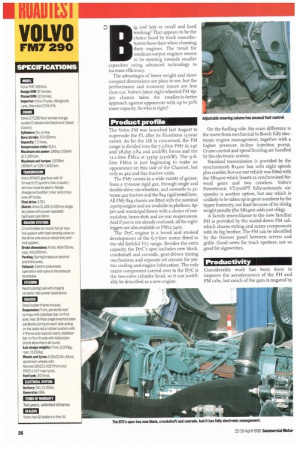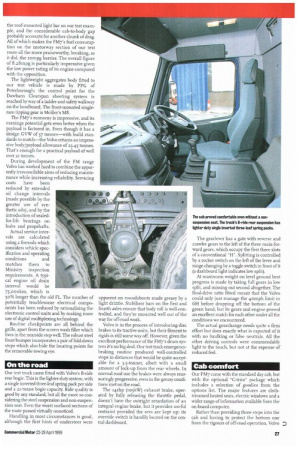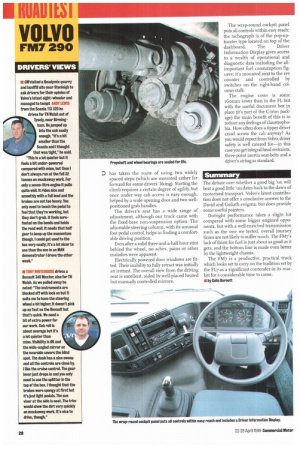0 ig and lazy or small and hard
Page 28

Page 29

Page 30

If you've noticed an error in this article please click here to report it so we can fix it.
working? That appears to be the choice faced by truck manufacturers these days when choosing their engines. The trend for medium-output engines seems to be steering towards smaller capacities using advanced technology to increase efficiency.
The advantages of lower weight and more compact dimensions are plain to see, but the performance and economy issues are less clear cut. Volvo's latest eight-wheeled FM tipper chassis takes the smaller-is-better approach against opponents with up to 50% more capacity. So who is right?
Product profile
The Volvo FM was launched last August to supersede the FL after its illustrious 13-year career. As far the UK is concerned, the FM range is divided into the 7.3-litre FM7 in 247 and 282hp (184 and 210kW) forms and the 12J-litre FM1.2 at 335hp (2.5okW). The 9.6litre FMto is just beginning to make an appearance on this side of the Channel, but only as 4x2 and 6x2 tractive units.
The FM7 comes in a wide variety of guises, from a 17-tonne rigid 4,X2, through single and double-drive six-wheelers, and onwards to 32tonne 4x2 tractors and the 8x4 rigid tested here. All FM7 8x4 chassis are fitted with the nominal 2,9ohp engine and are available in platform, tipper and municipal forms with a choice of normal-duty, heavy-duty and air rear suspensions. And if you're not already confused, all the eightleggers are also available as FMI2 340s.
The D7C engine is a bored and stroked development of the 6.7-litre motor fitted to the old faithful F L7 range. Besides the extra capacity, the D7C's spec includes new block, crankshaft and conrods, gear-driven timing mechanism and separate oil circuits for piston cooling and engine lubrication. The only major component carried over to the D7C is the two-valve cylinder head, so it can justifiably be described as a new engine.
On the fuelling side, the main difference is the move from mechanical to Bosch fully electronic engine management, together with a higher pressure in-line injection pump. Cruise control and speed limiting are handled by the electronic system.
Standard transmission is provided by the synchromesh R1400 box with eight speeds plus crawler, but our test vehicle was fitted with the SRi400 which boasts 12 synchronised forward gears and two crawlers. Volvo's Powertronic VTI7o6PT fully-automatic sixspeeder is another option, but one which is unlikely to be taken up in great numbers by the tipper fraternity, not least because of its r6okg weight penalty (the SIZI400 adds just t6lcg).
A family resemblance to the now familiar FH is provided by the scaled-down FM cab, which shares styling and many components with its big brother. The FM can be identified by the thinner panel between screen and grille. Good news for truck spotters; not so good for signwriters.
Productivity
Considerable work has been done to improve the aerodynamics of the FH and FM cabs, but much of the gain is negated by the roof-mounted light bar on our test example, and the considerable cab-to-body gap probably accounts for another chunk of drag. All of which makes the FM7's fuel consumption on the motorway section of our test route all the more praiseworthy, breaking, as it did, the rompg barrier. The overall figure of 8.28mpg is particularly impressive given the low power rating of its engine compared with the opposition.
The lightweight aggregates body fitted to our test vehide is made by PPG of Peterborough; the control point for the Dawbarn Clearspan sheeting system is reached by way of a ladder and safety walkway on the headboard. The front-mounted single. ram tipping gear is Meiller's M8.
The FM7's economy is impressive, and its earnings potential gets even better when the payload is factored in. Even though it has a design GVW of 37 tonnes—with build standards to match—the Volvo returns an impressive body/payload allowance of 2345 tonnes. That's enough for a practical payload of well over 21 tonnes.
During development of the FM range Volvo has worked hard to combine the apparently irreconcilable aims of reducing maintenance while increasing reliability. Servicing costs have been reduced by extended oil change intervals (made possible by the greater use of synthetic oils), and by the introduction of sealedfor-life bearings on hubs and propshafts.
Actual service intervals are calculated using a formula which considers vehicle specification and operating conditions and matches them to Ministry inspection requirements. A typical engine oil drain interval would be 75.000lcm, which is 5o% longer than the old FL The number of potentially troublesome electrical components has been reduced by rationalising the electronic control units and by making more use of digital multiplexing technology.
Routine checkpoints are all behind the grille, apart from the screen wash filler which lives in the nearside step well. The robust steel front bumper incorporates a pair of fold-down steps which also hide the locating points for the removable towing eye.
On the road
Our test truck came fitted with Volvo's B-ride rear bogie. This is the lighter-duty system, with a single inverted three-leaf spring pack per side and a 21-tonne bogie capacity. Ride quality is good by any standard, but all the more so considering the steel suspension and non-suspension seat. Even the worst surfaced sections of the route passed virtually unnoticed.
Handling in most circumstances is good. although the first hints of understeer were apparent on roundabouts made greasy by a light drizzle. Stabiliser bars on the first and fourth axles ensure that body roll is well-controlled, and they're mounted well out of the way for off-road work.
Volvo is in the process of introducing disc brakes to its tractive units, but their fitment to rigids is still some way off. However, given the excellent performance of the FM7's drum system it's no big deal. Our test track emergencybraking routine produced well-controlled stops in distances that would be quite acceptable for a 3.5-tonner, albeit with a small amount of lock-up from the rear wheels. In normal road use the brakes were always reassuringly progressive, even in the greasy conditions met on the road.
The rerrhp (ro5kW) exhaust brake, operated by fully releasing the throttle pedal, doesn't have the outright retardation of an integral engine brake, but it provides useful restraint provided the revs are kept up; its override switch is handily located on the central dashboard.
The gearlever has a gate with reverse and crawler gears to the left of the three main forward gears, which occupy the first three slots of a conventional "H". Splitting is controlled by a rocker switch on the left of the lever and range changing by a toggle switch in front of it (a dashboard light indicates low split).
At maximum weight on level ground best progress is made by taking full gears in low split, and missing out second altogether. The final-drive ratio fitted meant that the Volvo could only just manage the 40mph limit in 6H before dropping off the bottom of the green band, but its gears and engine proved an excellent match for each other under all the conditions we encountered.
The actual gearchange needs quite a firm effort but does exactly what is expected of it with no baulking or false neutrals. All the other driving controls were commendably light to the touch, but not at the expense of reduced feel.
Cab comfort
Our FM7 came with the standard day cab, but with the optional "G-trim" package which includes a selection of goodies from the options list. The major features are clothtrimmed heated seats, electric windows and a wider range of information available from the on-board computer.
Rather than providing three steps into the cab and having to protect the bottom one from the rigours of off-road operation, Volvo
has taken the route of using two widely spaced steps (which are mounted rather far forward for some drivers' liking). Starting the climb requires a certain degree of agility, but once under way cab access is easy enough, helped by a wide opening door and two wellpositioned grab handles.
The driver's seat has a wide range of adjustment, although our truck came with the fixed-base non-suspension option. The adjustable steering column, with its unusual foot pedal control, helps in finding a comfortable driving position.
Even after a solid three-and-a-half hour stint behind the wheel, no aches, pains or other maladies were apparent.
Electrically powered door windows are fitted. Their inability to fully retract was initially an irritant. The overall view from the driving seat is excellent, aided by well-placed heated but manually controlled mirrors. The wrap-round cockpit panel puts all controls within easy reach: the tachograph is of the pop-uptoaster type located on top of the dashboard. The Driver Information Display gives access to a wealth of operational and diagnostic data including the allimportant fuel consumption figures: it's mounted next to the rev counter and controlled by switches on the right-hand column stalk.
The engine cover is some 'Gomm lower than in the FL but with the useful document box in place (it's part of the C-trim package) the main benefit of this is to reduce any feelings of claustrophobia. How often does a tipper driver crawl across the cab anyway? As you would expect from Volvo, driver safety is well catered for—in this case you get integral head restraints, three-point inertia seat-belts and a driver's airbag as standard.
Summary
The debate over whether a good big 'un will beat a good little 'un dates back to the dawn of motorised transport. Volvo's latest contribution does not offer a conclusive answer to the David and Goliath enigma, but does provide some useful pointers.
Outright performance takes a slight hit compared with some bigger engined opponents, but with a well-matched transmission such as the one we tested, overall journey times are not likely to suffer much. The FM7's lack of thirst for fuel is just about as good as it gets, and the bottom line is made even better by the lightweight chassis.
The FM7 is a productive, practical truck which looks set to carry on the tradition set by the FL7 as a significant contender in its market for a considerable time to come.
• by Coin Barnett








































































































